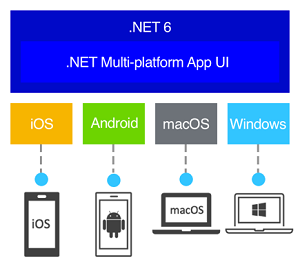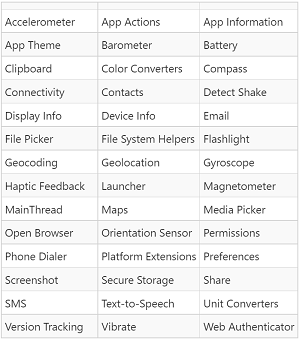News
Sporting a New MenuBar, .NET MAUI Heads for Release Candidate
Addressing an impressive array of issues, .NET MAUI has gotten a new MenuBar in Preview 14, the last stop before it reaches Release Candidate status.
About 180 GitHub issues were resolved in the preview, according to the release notes for the .NET Multi-platform App UI framework for building native device applications across mobile, tablet and desktop platforms. It's for that latter capability that Microsoft calls .NET MAUI the "evolution" of Xamarin.Forms, the mobile-only framework which it replaces.
 [Click on image for larger view.] .NET MAUI (source: Microsoft).
[Click on image for larger view.] .NET MAUI (source: Microsoft).
With the dev team polishing things up for RC status, only one new feature was added and it pertains to desktop development, according to a March 16 post by principal program manager David Ortinau.
"While desktop app navigation and menus are often designed into the content window of many modern applications (think Teams left sidebar or Maps top tabs), there's still a strong need for a traditional menu that resides at the top of the app window on Windows, and in the title bar on macOS," he said.
With few new features to explain, Ortinau discussed File Picker and Connectivity APIs as examples of "essential" functionality that developers can leverage for non-UI-specific coding tasks.
 [Click on image for larger view.] .NET MAUI 'Essential' APIs (source: Microsoft).
[Click on image for larger view.] .NET MAUI 'Essential' APIs (source: Microsoft).
"While combing through your feedback in previous .NET MAUI releases we have noticed a theme of questions such as 'how do I add a FilePicker,' 'how do I get check the connectivity of my app' and other such 'essential' application tasks that aren't specifically UI," Ortinau said.
"Within .NET MAUI is a set of APIs located in the Microsoft.Maui.Essentials namespace that unlock common features to bring that same efficiency to non-UI demands as to creating beautiful UI quickly. Originally a library in the Xamarin ecosystem, Essentials is now baked into .NET MAUI and is hosted in the very same dotnet/maui repository (in case you're wondering where to log your valuable feedback)."
As far as that RC status, Ortinau said in response to a question that this release almost qualified as an RC, but about 11 control-related tasks remained to be implemented. So the next release will be the RC, though the "Main branch is branding artifacts as RC," which apparently means it's just about feature-complete.
That means it's running about five or six months behind .NET 6, in which it was supposed to debut. However, .NET MAUI "slipped the schedule" and wasn't completed in time for .NET 6, which shipped last November. This is the fourth .NET MAUI preview since then. As Microsoft has said .NET MAUI will reach General Availability sometime in the first half of this year, forecasting an RC in the first quarter of the year, it looks like it slipped that schedule a little, too.
Developers can access the preview .NET MAUI bits in Visual Studio 17.2 Preview 2, which also shipped this week.
About the Author
David Ramel is an editor and writer at Converge 360.